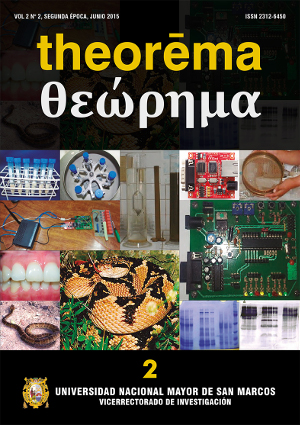Wild reservoirs of Trypanosoma cruzi in four locations of Amazon and Loreto regions
Keywords:
Trypanosoma cruzi, Reservoroirs, Amazon, Xenodiagnosis, Vector.Abstract
The study aimed to identify reservoirs of Trypanosoma cruzi in four locations in the Amazonas and Loreto region, capturing and analyzing marsupials, rodents and bats. The study was conducted in the province of Maynas, department of Amazonas (CP Tres Marias and Ron) and in the province of Utcubamba, department of Loreto (village Cahuide and Manacamiri). Rodents and marsupials were captured using Tomahawk and Sh0.2erman traps, and bats mist nets used; then the animals were anesthetized for Xenodiagnosis technique. 95 individuals corresponding to 16 species, Loreto showed higher rates of biodiversity; however Amazonas showed the highest prevalence of individuals known reservoir of T. cruzi were captured. Of the 47 individuals analyzed was obtained that 10, 68% (5/45) were positive for T. cruzi: Didelphis marsupialis, Mus musculus and Phyllostomus elongatus. It is reported as new reservoir for P. ellongatus in Peru. No significant difference between the studied was found.Downloads
Published
Issue
Section
License
Copyright (c) 2016 Hilda María Solís, Nancy Carlos

This work is licensed under a Creative Commons Attribution-NonCommercial-ShareAlike 4.0 International License.

Theorema segunda época by Vicerrectorado de Investigación y Posgrado is licensed under a Creative Commons Reconocimiento-NoComercial-CompartirIgual 4.0 Internacional License.
Creado a partir de la obra en http://revistasinvestigacion.unmsm.edu.pe/index.php/Theo/index.
AUTHORS RETAIN THEIR RIGHTS:
a. Authors retain their trade mark rights and patent, and also on any process or procedure described in the article.
b. Authors retain their right to share, copy, distribute, perform and publicly communicate their article (eg, to place their article in an institutional repository or publish it in a book), with an acknowledgment of its initial publication in the Theorema segunda época.
c. Authors retain theirs right to make a subsequent publication of their work, to use the article or any part thereof (eg a compilation of his papers, lecture notes, thesis, or a book), always indicating the source of publication (the originator of the work, journal, volume, number and date).



